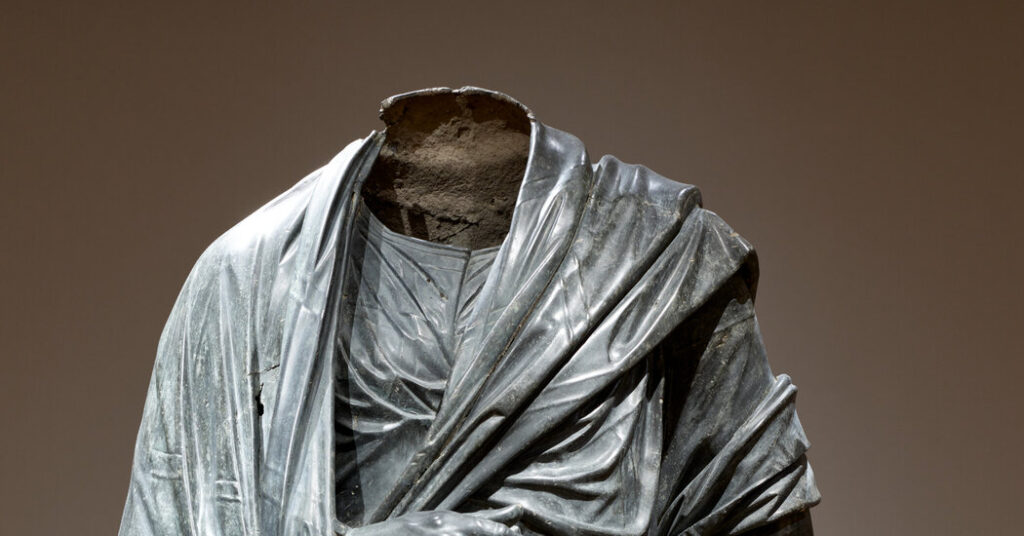With its flowing robes and stoic posture, the bigger-than-life bronze statue believed to symbolize the good Roman statesman Marcus Aurelius had, since 1986, held delight of place within the Greek and Roman galleries on the Cleveland Museum of Art.
Now the statue is off show, seized beneath a warrant earlier this month by the Manhattan district lawyer’s workplace. The workplace stated on Thursday that the seizure was associated to an “ongoing criminal investigation into a smuggling network involving antiquities looted from Turkey and trafficked through Manhattan.”
In their warrant, investigators put the worth of the statue, which is headless, at $20 million, and stated it was about 1,800 years outdated. They stated it will be transported to New York in September.
According to the district lawyer’s Antiquities Trafficking Unit, the accused traffickers had been based mostly in New York, giving the unit authorized authority to grab the statue from one other state as a result of New York was the “focal point of the conspiracy.” Officials wouldn’t elaborate on the case.
Turkish officers stated they’ve been telling the Cleveland museum that the statue, which is 6 toes 4 inches tall with out its head, had been stolen within the Sixties throughout a looting spree at an archaeological website in Bubon, in southwestern Turkey. The officers stated the museum had fended off their claims, saying Turkey might present no onerous proof of theft.
Zeynep Boz, the top of the Department for Combating Illicit Trafficking at Turkey’s Ministry of Culture and Tourism, stated in a press release that “the enduring dispute surrounding this matter has kept Marcus Aurelius separated from his hometown for far too long.”
In a press release, the Cleveland museum stated its coverage is to not publicly focus on “whether a claim has even been made,” however that it “takes provenance issues very seriously and reviews claims to objects in the collection carefully and responsibly.”
In the previous 12 months, as a part of its investigation into the Turkish looting claims, the antiquities unit has seized artifacts on the Metropolitan Museum of Art; the Museum of Greek, Etruscan, and Roman Art at Fordham University; and the Worcester Art Museum in Massachusetts.
The seized works embody stone and bronze statuary courting again to an period when Turkey was part of the Roman Empire in a area referred to as Anatolia or Asia Minor. The unit’s most up-to-date seizure was first reported by The Cleveland Plain Dealer.
Turkey’s declare on the statue hinged partly on persuading investigators that the statue the truth is depicted Marcus Aurelius, as a result of the stone plinth the place they are saying it had stood is inscribed with that emperor’s identify.
The Cleveland museum’s web site had till lately described the statue as “The Emperor as Philosopher, probably Marcus Aurelius (reigned AD 161-180),” including that the merchandise had originated from “Turkey, Bubon(?) (in Lycia), Roman, late 2nd Century.” They additionally wrote in an accompanying description that the statue “likely represents Marcus Aurelius, the Roman emperor known for his philhellenism and Stoic writings.” (Aurelius wrote “Meditations,” a traditional work on Stoic philosophy.)
But a number of weeks in the past, the museum eliminated the sooner references to Turkey and Aurelius and altered the web site to learn: “Draped Male Figure, c. 150 BCE-200 CE,” including, “Roman or possibly Greek Hellenistic.” It additionally altered the language of its accompanying description to learn “without a head, inscription, or other attributes, the identity of the figure represented remains unknown.”
Asked in regards to the adjustments, a museum spokesman would solely say that different data on the positioning, like an inventory displaying places the place the statue had beforehand been displayed, remained the identical.


